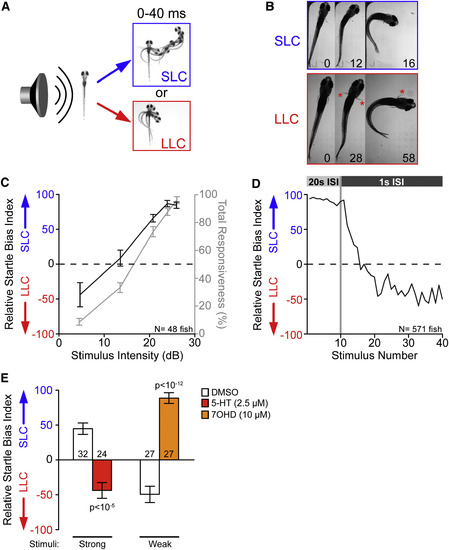Fig. 1
- ID
- ZDB-FIG-180724-66
- Publication
- Jain et al., 2018 - A Forward Genetic Screen in Zebrafish Identifies the G-Protein-Coupled Receptor CaSR as a Modulator of Sensorimotor Decision Making
- Other Figures
- All Figure Page
- Back to All Figure Page
|
Selection of Appropriate Behavioral Responses to Acoustic Stimuli Is a Dynamic Process (A) Temporal projections over 40 ms post-stimulus of wild-type 5-dpf larvae performing SLC and LLC behaviors. (B) Time course of the initial C-bend of wild-type (WIK) fish performing SLC and LLC responses, 16 dpf. Numbers show elapsed time (in milliseconds) after stimulus; red asterisks indicate active pectoral fin usage. (C) Average behavioral bias (black, left axis) and response frequency (gray, right axis) of 48 larvae (5 dpf) to acoustic stimuli (p < 0.0001, Kruskal-Wallis test). Relative startle bias index was calculated for each larva at each intensity (see STAR Methods). (D) Average relative startle bias of 5-dpf larvae following identical 26-dB stimuli at 20-s intervals (stimuli 1?10) and then 1-s intervals (stimuli 11?40). (E) Average relative startle bias of 5-dpf larvae treated for 20 min with serotonin (5-HT) or dopamine D3 receptor agonist R-(+)-7-Hydroxy-DPAT (7OHD). Numbers of larvae tested are given at base of bars. Error bars indicate SEM. See also Figures S1 and S2, Table S1, and Video S1. |
| Fish: | |
|---|---|
| Conditions: | |
| Observed In: | |
| Stage: | Day 5 |

